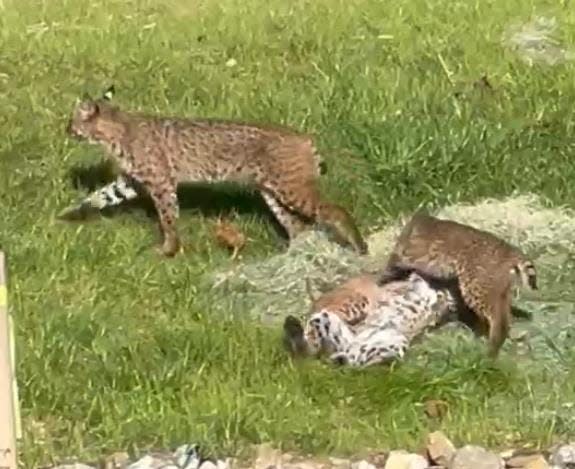
Those aren’t just big cats playing in a suburban Des Moines yard.
West Des Moines resident Mason Adams captured video of a family of bobcats playing near Fuller Road and South 19th Street on Sunday. The neighborhood is close to Raccoon River Park.
Vince Evelsizer, wildlife biologist at Iowa DNR, said the video appears to be a mother and her three grown kittens.
What should I do if I see a bobcat in Iowa?
Bobcats were once an endangered species in Iowa, according to the Iowa Department of Natural Resources. Over the years, their population has rebounded.
Evelsizer said the bobcat population is trending upward, particularly in eastern and western Iowa.
While the bobcats are more common, sightings are still unusual, the DNR said. Bobcats prefer to keep themselves and can travel as much as 10 miles per week.
While they’re usually not dangerous to humans, you should still keep your distance from bobcats, the DNR said.
If you spot a bobcat in Iowa that appears sick or injured, you should report it to DNR.
More: Elk found along I-80 after apparent collision, Iowa State Patrol says
Iowa does allow hunting. When is bobcat season?
As bobcat levels rebounded, Iowa opened a limited hunting season.
Bobcat hunting is legal in parts of Iowa from Nov. 2, 2024 to Feb. 28, 2025. If you take a bobcat, you must contact a DNR conservation officer within 24 hours to receive a CITES tag.
Hunters or trappers in the southern three rows of counties can take up to three bobcats per season. Other counties are limited to a single bobcat and 43 counties, mostly in northern and eastern Iowa, have a hunting ban in place.
How to tell the difference between a bobcat and a mountain lion
Bobcats are one of three wildcats native to Iowa, DNR says, along with the lynx and mountain lion. Only bobcats still have established populations in the state. Mountain lions and lynx that are seen are often just passing through the state.
Bobcats are often mistaken for their larger mountain lion relatives, but here’s how to tell them apart, from Iowa DNR:
-
The mountain lion has a long tail (2.5-3 feet), while the bobcat has a short “bobbed” tail that’s smaller than 10 inches.
-
Bobcats are only 3 feet in length, while adult male mountain lions are 7 to 9 feet. For comparison, a house cat is usually about 18 inches long.
-
Mountain lions weigh 90 to 160 pounds, while bobcats weigh 20 to 30 pounds.
-
Bobcats tend to be darker brown, with lighter belly fur and spots, while mountain lions tend to be a more uniform brown, tawny color.
More: Coyotes surprised an Urbandale resident at her home. How to handle a coyote encounter
West Des Moines reports multiple bobcat sightings
“In recent months, West Des Moines Neighborhood Services Specialists have received numerous reports of bobcat sightings around the city, sparking concerns among residents,” the city of West Des Moines posted online.
With their increasing presence, the city put together a list of quick tips:
-
Stay Calm and Back Away Slowly: If you spot a bobcat, the best course of action is to remain calm and avoid sudden movements. Back away slowly while maintaining eye contact with the animal. Do not run, as this may trigger the bobcat’s instinct to chase.
-
Do Not Approach or Feed the Bobcat: It’s crucial to keep a safe distance from the bobcat and never attempt to approach or feed it. Feeding wild animals may make them more familiar to human presence, leading to potential conflicts in the future.
-
Protect Your Pets: When in bobcat territory, it’s important to keep your pets indoors or supervised when outside. Ensure that your pets are up-to-date on their vaccinations and consider installing motion-activated lights or fencing to deter wild animals from entering your property.
-
Make Noise: If a bobcat lingers near your home or exhibits bold behavior, you can try to scare it away by making loud noises, such as shouting. This can help reinforce the bobcat’s natural fear of humans.
-
Contact Local Authorities: If you encounter a bobcat that appears sick or injured, contact Neighborhood Services at 515-222-3364 or the Iowa DNR for assistance.
Victoria Reyna-Rodriguez is a general assignment reporter for the Register. Reach her at [email protected] or follow her on Twitter @VictoriaReynaR.
This article originally appeared on Des Moines Register: What should you do if you see a bobcat? What to know:
Source Agencies

